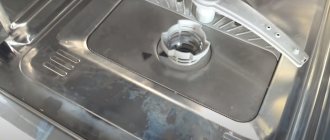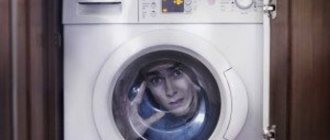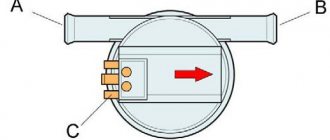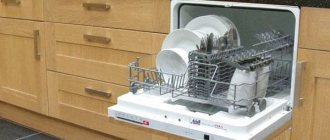Competent care
The rules for caring for household appliances do not depend on who their manufacturer is. When carrying out the disinfection procedure for the machine, follow the instructions for using cleaning products:
- Add the required amount of substance to the compartment without exceeding the recommended dosage.
- Select a long program and a water heating temperature of up to 60 °C.
Expert opinion
I work in the household appliance repair industry. Extensive experience in restoring washing machines and dishwashers.
Ask a Question
The difference between brands is that some manufacturers' dishwashers are equipped with an automatic cleaning option.
Experts are confident that deep cleaning of the accessible parts of the device once every six months can double the period of its uninterrupted operation.
Caring for your dishwasher requires the user's attention. The equipment will not lose its functionality and appearance if cleaning is carried out regularly. Industrial dishwasher cleaners are presented in a wide range of household departments.
How to use a Bosch dishwasher: rules and nuances of operation
Where to start using it?
A dishwasher is bought in order to make the housewife’s work easier and ensure reasonable water savings. In order not to prepare yourself for unpleasant surprises from the very beginning, the installation and connection of this household appliance should be entrusted to specialists.
So, the machine is placed in the designated place, and the water supply and drain are connected. Now you can start using it.
Why do you need a “idle” start?
Bosch, like a number of other manufacturers of household appliances, strongly recommends a test run of the dishwasher.
It is necessary to make a “idle” start for the following reasons:
- lubricants accidentally preserved on parts of the product, as well as dust and debris that got inside should be eliminated;
- we get the opportunity to check how well the machine is installed, evaluate the rate of water flow, its heating level, see how the entire work process proceeds, including the draining and drying stages;
- When problems are identified, it becomes possible to eliminate them at the test washing stage, eliminating the labor-intensive unloading of dishes.
We know that during regular washing you cannot do without special products, but a test run in this sense is no exception. You will need the regenerating salt and other detergents included in the starter kit that customers are usually asked to purchase with their dishwasher.
A test run of the dishwasher is necessary, first of all, to check the quality of its installation and make sure that the unit is in good working order.
First start algorithm
What we need to know about the operating conditions of the purchased equipment is the level of water hardness in the region where it will operate. You are in luck with Bosch machines: buyers of this company’s products do not need to be guided by their own experience when determining hardness, or resort to traditional methods.
A number of models of this brand include test strips for determining hardness. You just need to lower the paper strip with the reagents applied to its surface into the water for just a couple of seconds.
And then compare it with the table provided by the manufacturer. After completing these simple steps, you will be ready to test run your purchase.
Proper connection of the dishwasher involves installing it in a specific place (1) and connecting it to the electrical network (2), water supply (3) and sewerage (4) using standard hoses and a power cord
The startup procedure is quite simple, you need to follow these steps sequentially:
- open the car by pulling the door towards you;
- pull out the lower basket to gain access to the lid covering the water softening salt reservoir;
- unscrew the lid, pour water into the reservoir and pour special salt from the starter kit into it;
- screw on the tank lid and remove any water that may have spilled into the chamber while loading salt with a rag;
- Now set the salt consumption on the control panel, taking into account the previously determined water hardness.
Let's add some clarification. Please note that water is poured into the salt tank only once - before the first start. It should be filled to the top.
The salt is poured in using a special funnel (or watering can), which is usually included in the kit. If you don't have a watering can, use a regular cup. Add salt until it becomes visible through the filler hole.
Water is poured into this hole, located at the bottom of the unit’s chamber, and special salt intended for dishwashers is added.
The water displaced during the backfilling process should not confuse you: this is how it should be. Once the reservoir lid is closed, the displaced water should be thoroughly wiped away. It should not be inside the camera.
It remains to check whether the water supply tap is open, after which you can activate the first start. To visualize the entire algorithm of actions, watch the video that we posted at the bottom of this article.
Security measures
When receiving the goods, pay attention to the integrity of the packaging: if it is damaged, you need to make sure that the dishwasher body is in good condition.
Before turning on the dishwasher, you should compare the characteristics of the electrical network at the connection point with the data of the device itself: power consumption and the required cross-section of the supply wires. The washing unit must be securely installed and have easy access to the switching point.
During operation, you must follow the established rules:
- Place cutlery point down or horizontally in the dish compartment;
- Do not place heavy products on the open door of the washing chamber to avoid the machine tipping over;
- Solvents can cause the device to explode and are therefore prohibited for use as a detergent;
- It is necessary to disconnect the unit from the water supply and electrical network if necessary to carry out minor repairs.
Sequence of actions (photo source - Yandex.Images)
For different models of dishwashers from the Bosch family, additional conditions may be specified, but the basic rules are the same for all.
An ideal option for a safe built-in modification of a dishwasher is Bosch Silence Plus. This model is equipped with an inverter motor, which saves energy. The machine has 5 programs, but the main advantage is rinsing dishes with hot water. This effectively removes any remaining detergent. The device has a child safety feature and prevents leaks and damage.
How to care for PMM?
Rules of care
- Equipment should not be idle. Regular use of the device prevents the formation of bacteria - no matter how you wash the camera, microscopic food remains remain in it.
- During preventive measures, the chamber must be empty.
- Check the rotating nozzles for blockages and clean them if necessary. Clogged nozzles interfere with the normal flow of water - the dishes will not be washed properly.
- All parts of the PMM must be cleared of debris. To do this, use tweezers, toothpicks - in other words, something thin and pointed. If you use a metal tool, try not to leave scratches on the surface of the device.
- Wipe down doors and gaskets. There are places in the chamber that are washed worse than others during operation. They need to be thoroughly wiped with a cloth and special detergent. You can reach hard-to-reach areas with a toothbrush.
- Clean the bottom of the door—debris can accumulate in this so-called “dead spot.” Particularly thorough cleaning will be required here.
- Clean the bottom of the machine near the drain. To do this you will have to get baskets, because you need free access. Use caution - clean carefully. There may be fragments of broken dishes and other solids in the drain.
- Remove scale using one of the recommended products - special or homemade, such as vinegar and lemon juice. This procedure is performed last. The PMM is launched without dishes.
- Wash the front area with a sponge and a mild detergent. Pay special attention to the panel, handle and tabs.
- Refill your machine with fabric softener monthly. However, it is not necessary if you are using a water softener. In addition, rinse aid is contained in a number of detergents - read their composition.
- Clean the plastic elements with a brush. Use liquid soap if necessary.
Internal cleaning of PMM
To clean the inside of the machine, double caution is required:
- Disconnect the device from the power supply.
- After unscrewing the screws, remove the sprinkler and other elements. Try to remember the sequence of actions - you can even take a photo so you don’t miss anything during assembly. Store the parts in a safe place in the order in which they are removed.
- When finished cleaning, install the parts in reverse order. When tightening screws into plastic, do not use excessive force.
- Now you can connect the machine to the mains.
How to get rid of mold?
Fungus and mold cannot appear with the care described above. Their occurrence indicates a violation of the service rules. You should immediately begin to exterminate microorganisms and take measures to prevent their proliferation. Recommended action plan:
- Clean the inside of the appliance with bleach in a ratio of 0.5 cups per 1 liter of water;
- Wipe the chamber with a solution of ammonia in a ratio of 1/4 cup per liter of water;
- Turn on rinse mode.
To prevent the formation of mold, it is recommended not to close the machine door after the next wash.
Important! Bleach should be used with extreme caution - it is quite caustic. If the body is made of stainless steel, their use is prohibited. Bleach should not be used in combination with other chemicals.
How to get rid of rust?
Rust is already a direct threat to the performance of the elements affected by it. If corrosion stains appear on the basket, it is better to change it. You can also use sealant paint. In any case, it is important to understand what causes corrosion. It can be caused by high iron content in water. This may be due to a natural feature - and there is nothing you can do about it - or to rusty pipes. In any case, it is recommended to install special filters.











